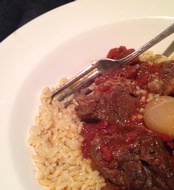WINE WITH…Stifado (Greek Beef Stew)
Our planet abounds with beef stews! There is scarcely a country in the world that doesn’t add its own subtle but distinct flavor to the standard dish of beef simmered for hours in broth, wine, or water (or all of the above). The Irish simmer beef stew in Guiness or other stout; Asian versions are usually fragrant with fresh ginger, soy sauce, fish sauce and sesame oil, while sour cream is an important ingredient in Russian renditions. The traditional American interpretation of beef stew, simmered in water rather than wine, includes a host of veggies (carrots, bell peppers, celery, potatoes), to which Italians might add mushrooms and red wine. Hungarians season their stews liberally with paprika, and France’s Boeuf Bourguignon is distinguished by smoky bacon and flavorsome red wine. As for Greek Stufado, onions and cinnamon, along with both red wine and vinegar, are traditional.
above). The Irish simmer beef stew in Guiness or other stout; Asian versions are usually fragrant with fresh ginger, soy sauce, fish sauce and sesame oil, while sour cream is an important ingredient in Russian renditions. The traditional American interpretation of beef stew, simmered in water rather than wine, includes a host of veggies (carrots, bell peppers, celery, potatoes), to which Italians might add mushrooms and red wine. Hungarians season their stews liberally with paprika, and France’s Boeuf Bourguignon is distinguished by smoky bacon and flavorsome red wine. As for Greek Stufado, onions and cinnamon, along with both red wine and vinegar, are traditional.
In Greece, where Stifado is sometimes made with rabbit instead of beef, some cooks go for a sweet-and-sour effect by simmering raisins or prunes in the mélange, but of course this will tilt the flavors in a somewhat different wine direction than the recipe we followed.
Stifado
Serves 4-6
Stifado is definitely best made a day or two ahead so that the meat can soak up all the flavors. Baby or pearl onions are traditional, and if you like the frozen ones you can use those. We prefer fresh shallots, which add a rich, vibrant punch of flavor to the dish.
We like to keep with Greek tradition and serve Stifado over orzo, but rice is a good alternative. Another tasty option is to put thick slices of good, toasted bread rubbed with garlic and drizzled with olive oil, either in the bottom of each individual plate or bowl, or on top of each serving.
2-3 pounds stewing beef (chuck is ideal) cut in 2-3 inch pieces
Salt and pepper
4 tablespoons olive oil, divided use
About 2 pounds shallots or baby onions, peeled and trimmed but left whole
3-4 cloves garlic, minced
One 28-ounce can whole tomatoes
1 heaping tablespoon tomato paste
1 bay leaf
½ teaspoon ground cloves
1 cinnamon stick
2 tablespoons red wine vinegar
¾ cup red wine
Preheat the oven to 300°
Place the beef in a bowl and toss with salt and freshly ground black pepper. Set aside. Heat 3 tablespoons of the olive oil in a large pot and add the shallots (or onions). Cook over medium to low heat, stirring frequently, until the shallots have started to color slightly, about 5-8 minutes. Remove them to a bowl and add the remaining tablespoon of olive oil. Add the beef and cook, stirring occasionally, until the meat has browned. Return the shallots to the pan and stir in the garlic. Pulse the tomatoes (with their juice) in a blender or food processor 2 or 3 times until they are coarsely chopped but not fully pureed. Add to the pot along with the remaining ingredients. Bring the mixture back to a simmer, then cover the pot and transfer it to the oven. (Alternatively, the Stifado can be simmered over very low heat on the stovetop). Cook for about 2-21/2 hours, or until the meat is spoon-tender.
This hearty dish demands to be paired with an equally hearty red wine. Because the meat is slow-cooked for a long time, it does not require firm tannins, but does need full, forward flavors. These can be fruity, as with the Petite Sirah we are recommending, or earthy, as with the Gigondas, but the key point is to choose a wine that is in no sense shy. It instead needs to strut its stuff proudly.
|
Selection
|
Approx. Price |
Comments |
|
E. Guigal, Gigondas (France) 2011(Imported by Vintus LLC)
|
$31 |
Redolent of both red and black summer fruits with an evocative undercurrent reminiscent of dried sage, lavender, thyme, and other herbs, this is an impeccably balanced wine that only gained more and more flavor when paired with the Stufado. A stellar pairing!
|
|
Jaumne Frau I Grau, Pla de Bages (Spain) “Sensvs” Crianza 2012 (Imported by The Spanish Wine Importers)
|
$25 |
A very seductive wine, this blend of Cebernet Franc and Syrah hails from a very small denominación near Barcelona. Supple on the palate, it tastes spicy, with secondary flavors that resemble nutmeg, all enhanced by the cinnamon in the dish.
|
|
J. Lohr, Paso Robles (California) Petite Sirah “Tower Road” 2013
|
$35 |
A powerful wine, as befits the grape variety, this Petite nonetheless exhibits well-tamed tannins and good balance. It fairly overflows with rich, succulent blue and blackberry fruit flavors. |
|
Luca, Uco Valley, Mendoza (Argentina) Syrah “Laborde Double Select” 2011 (Imported by Vine Connections)
|
$24 |
A muscular Syrah, with earthy undertones, but far more ripe, primary fruit flavor, this is not a wine for the faint of heart or palate. The Stufado, though, seemed to calm it down, and impart a note of calm and perhaps even elegance. |
|
Pezzi King, Dry Creek Valley, Sonoma County (California) Zinfandel 2012
|
$26 |
An impressive, claret-styled Zin, with ripe, briary flavors but also admirable restraint. The wine does not slap you in the face, but instead softly, gently, and very successfully seduces you with its myriad charms.
|
